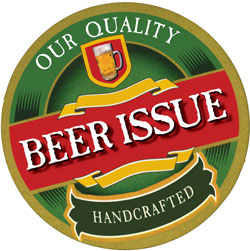If you’ve been to a decent multitap pub or restaurant with a good bar lately, you can’t help but notice that, among all the other craft brews and imports, Belgian beers seem to be nearly everywhere. There are places that regularly feature a good Belgian ale or three, often in bottles as well as on tap. There’s one beer bar in town, the Stumbling Monk, that pretty much specializes in Belgian beers on tap; the lineup includes either beers imported from Belgium or beers made by North American breweries that emulate Belgian styles. The world’s biggest brewing company (in terms of volume), InBev, originated in Belgium, and InBev’s beers are widely available in Seattle.
I’m here to tell you that it most certainly was not always this way. A couple of decades ago, Belgian brewers weren’t too concerned about what people outside of their country thought about their beers, because the locals drank most of what was brewed there—a bewildering, enchanting array of idiosyncratic beers that were unlike anything made anywhere else. There were chewy, strong ales brewed by Trappist monks, rich dark beers like Chimay Rouge and Westmalle Dubbel, beers that filled your mouth up with a bounty of malt and subtle yeast accents. There were spicy seasonals (saisons), Wallonian ales traditionally brewed in rustic farmhouse settings for the thirsty field hands, with heavenly aromas and fluffy mouthfeel. There were delightfully refreshing witbiers, brewed with a mixture of barley malt and unmalted wheat, flavored with curaçao orange peel and coriander, with a gentle touch of quenching sourness. There were near- legendary Flemish old brown and red ales, beers that were aged in oak and subjected to a secondary fermentation, giving them amazing complex flavors, nearly indescribable, sweet and sour enmeshed and yet separate, dancing merrily on the tongue.
Seattle’s Merchant du Vin pioneered importing these wonders, marketing a brown abbey ale, St. Sixtus—rich and hearty, warming, and even a bit numbing. MdV also brought in Orval Trappist Ale, which tasted like nothing else brewed on earth—funky, acidic flavors tangled with hoppy bitterness, a strangely fruity malt body, and, some people swear, hints of bubble gum.
And there’s lambic: the last vestiges of the oldest brewing practices in the world, spontaneously fermented with airborne yeast—no pure cultures for these guys. They have peculiar aromas that are commonly referred to as “horse blanket” and “barnyard,” aromas not unfamiliar to fans of strong, aromatic cheeses. Tasting reveals a crazy patchwork of flavors—strong, citric, and even a little nasty—that are simultaneously repulsive and irresistible.
Not for you? Don’t be too sure. I recently held a Belgian ale tasting session for a group of women whose previous experience had ranged from “I think I tried one once” to “I don’t drink much.” If the follow-up thank-you notes were any indication, I need to do this more often. Belgian beers may be distinctive, but they are hardly threatening, and in most cases, their flavors are accessible and just plain delicious.
Local brewers have also been inspired by Belgian styles: Elysian Brewing, Snoqualmie Falls Brewing, Dick’s Brewing in Centralia, Fish Brewing in Olympia, Anacortes Brewing, and others have made saisons, abbey-style triples, and other beers that pay respect to Belgian brewing tradition and styles. Pick up some of these beers next time, and compare them to their Belgian counterparts. If the sincerest form of flattery is imitation, then our locally brewed Belgian styles do their inspirations proud.






